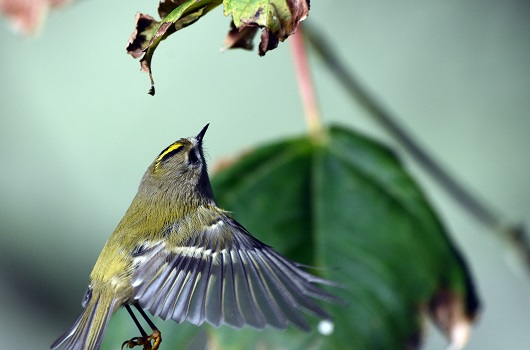Britain’s smallest bird affected by cold winters

Britain’s smallest bird species, the goldcrest, is being hit hard by cold winters, new analysis methods developed by researchers at the University of St Andrews have revealed.
The data analysis techniques, published today (Thursday 15 June) in Methods in Ecology and Evolution, take a longer term view over multiple locations and for a period of several years, compared to previous studies.
They showed that the cold temperatures strongly affected breeding numbers of the goldcrest, while in contrast, the song thrush was not affected by the cold, but benefitted from wet and mild summers.
During the study period 1994 to 2013, the mildest winter was in 2006 to 2007 and the coldest winter in 2009 to 2010. Within these three years, goldcrest populations in Britain decreased by an estimated 27 per cent, according to the new analysis methods.
Over the same period, numbers of the song thrush fell by 20 per cent in 2013 after a high in 2007, which followed a particularly warm summer in 2006.
Researchers developed the new method to help improve understanding of how wildlife may react to changes in climate. The method is helping reveal how susceptible species may be to, for example, cold winters or wet springs on different locations across Britain.
Dr Cornelia Oedekoven, of the Centre for Research into Ecological and Environmental Modelling (CREEM) at the School of Mathematics and Statistics, said: “Given the multi-dimensional nature of climate change, developing tools for incorporating multiple climatic factors in the analyses will ultimately be required to more fully understand the overall impact of climate change on wildlife populations.”
The research relied on the data gathered by thousands of volunteers for the British Breeding Birds Survey (BBS) organised by the British Trust for Ornithology (BTO), and weather data from the Met Office spanning the last 20 years.
Five bird species were looked at: goldcrest, song thrush, linnet, cuckoo and willow warbler, of which the first three are residents, and the other two are summer migrants. Bird species numbers were related to various factors and three different weather variables: winter temperature, breeding season temperature and breeding season rainfall.
Dr James Pearce-Higgins, Director of Science at the BTO, said: “This study adds to the evidence that warmer temperatures have boosted populations of many resident species, and driven northwards shifts in their distributions, although impacts on habitat specialists and long-distance migrants are less positive.”
This new method provides a starting point for boosting the ability to understand how changes in wildlife distribution and climate change are related. In the future, the researchers hope the method will be further developed to improve our knowledge on the impacts of climate change on wildlife.
The methods were developed in collaboration between the University of St Andrews, Biomathematics and Statistics Scotland, the BTO and Scottish Natural Heritage (SNH) and funded through the Scottish Government’s Centre of expertise ClimateXChange.
The Breeding Bird Survey is run by the BTO and jointly funded by the BTO, the Joint Nature Conservation Committee (JNCC) (on behalf of the Council for Nature Conservation and the Countryside, Natural England, Natural Resources Wales and SNH), and by the RSPB.
The paper ‘Attributing changes in the distribution of species abundance to weather variables using the example of British breeding birds’ by Cornelia S Oedekoven, David A Elston, Philip J Harrison, Mark J Brewer, Stephen T Buckland, Alison Johnston, Simon Foster and James W Pearce-Higgins is published in the 15/06/17 issue of Methods in Ecology and Evolution.
Picture caption
Goldcrest, Fifeness © Steve Buckland 2016
Background information
Dr Oedekoven is available for interview via the Communications Office – contacts below.
St Andrews has an in-house ISDN line for radio and a Globelynx camera for TV interviews. To arrange an interview please contact the Communications Office in the first instance.
BTO bird identification clips are available:
Know your thrushes: Song and Mistle
Identifying Goldcrest and Firecrest
Issued by the University of St Andrews Communications Office. Contact Gayle McIntyre on 01334 462530 or [email protected].
Category Research